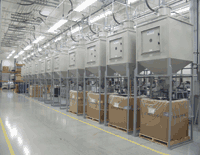WEB EXCLUSIVE: Plant design: A team sport
Delphi’s Vienna, OH facility annually moves about 10 million lb of more than 80 different materials from this central area to 120 molding machines.
March 1, 2005
|
IMM has been in several Delphi molding plants, most recently the new Delphi Connection Systems plant in Vienna, OH (September 2004 IMM). Each of them was so well organized that it was clear a lot of good planning went into it. We asked them how they do it.
In planning the Vienna plant, a greenfield site with 120 new Milacron-Fanuc electric machines, Delphi used its plant in Cortland, OH, as a template. When Cortland opened four years ago it set new benchmarks for efficiency and lean operation—cutting scrap by 68% and tool change time by 75%. That’s a tough act to follow, never mind top, but the Vienna plant did it. Opened five months ahead of schedule, it handles more parts and resin with fewer people and less floor space. Cycle times are faster, accuracy is greater, and the plant is greener.
Greg Pachol, Delphi’s manager of North American molding projects, says that before planning was even begun, an upfront global search was done for emerging industrial innovations. Those that made the most sense were adopted, whether used in plastics processing or not. The actual planning process begins by forming a team of process and production engineers, people with floor manufacturing experience such as quality systems specialists, production control engineers, and others.
Early Stages Count a Lot
The team first considers corporate strategy, localization, and the products to be made. It defines the business goals, does a projection and analysis of profit and loss, and sets manufacturing goals using lean manufacturing and other metrics.
Then it defines the production process for already-defined products. Pachol says Delphi knows it has a significant ability to impact long-term operating costs in the early stages. Once the process is set up, though, it’s harder to have a big impact, so they put in the work and the thinking up front.
Pachol says Delphi’s plastics production philosophy centers on the tooling. Accompanied by relevant materials information, it is the tool that drives machine size, which in turn drives the plant configuration and, ultimately, the whole facility. Therefore, a thorough cost analysis is done on factors such as cavitation, whether or not to use hot runners, and so forth.
The overall site is then computer modeled, taking into account ergonomics and movement of goods and people. In parallel, a services model is developed for air, water, lighting, power, air conditioning, etc. The support needed outside the production cells is defined, such as toolmaking and preventive maintenance. Issues considered include whether the machines should be electric or hydraulic and how much heat the machines will release in the plant.
Next comes actual production economics. The objective is to create as lean a cell as possible, concentrating on a smooth, uninterrupted workflow that Pachol says is tuned to customer demand. The flow through the whole facility is analyzed to see that it matches demand. Alternatives are listed and life-cycle costs are calculated on a per-piece basis for comparison.
Looking at a Delphi plant such as Vienna with its AGVs and extensive robotics, one could be misled. Yes, the company obviously believes in automation, but Pachol says a particular process could be very manual if that is the best solution.
Using machine, materials, operator, and workflow data, the team starts thinking about plant layout and design. A number of alternate proposals are considered and a lot of weight is given to future growth projections. Pachol says economies of scale are critical and care is taken to not exceed the point of diminishing returns on investments.
The optimized arrangement of machines and workflow are then given to the building design specialists with information on ceiling heights, machine loading, mold handling, and so forth.
The company looks to standardize on molding machines, material handling systems, and everything else, but suppliers have to meet predetermined specifications.
There is a lot of detail in the plan. Will material be precolored or masterbatched? Will reclaiming be central or machine-side? What about redrying if it’s at the machine? Pachol says all this production information is saved and there is an internal website where the best plastics production practices can be referenced.
These best practices are not static, but meant to be improved. Pachol says the best solution will vary around the world due to wage and utility rates and different suppliers. All variations become part of the knowledge base. Delphi’s overall approach is this: Here’s the best way we’ve found to do X—so far. Use it as a guideline and if you improve it or add something, put it onto the website.
Contact information |
About the Author(s)
You May Also Like





